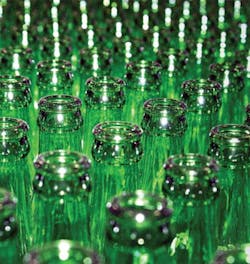In one application there, such technology is used to inspect glass beer bottles before reuse. Malted beverages are extremely popular in China, and 95% of all beer bottles are returned for recycling, inspected for damage, sterilized, and refilled. In a traditional setup, bottle inspection is performed manually. Of the roughly 3,000 bottling lines in China, almost all run at 18,000 to 24,000 bottles/hr and use human operators. To achieve these rates, each line must employ three shifts of 18 to 20 well-trained workers who inspect bottles on a fast-moving conveyor belt. Although manual inspection is labor intensive and can cause eyestrain and fatigue, most bottling lines running in Chinese plants operate this way.
One alternative is to employ machine vision to perform inspection tasks. To that end, Shangdong-based Mingjia Packaging Inspection Technology Co. Ltd. and Waterloo, Ontario-based Teledyne DALSA, a manufacturer of multicamera and digital-imaging products, are developing automated inspection systems for the Chinese-beer industry.
“Checking that bottles are fit for reuse is a task that can be accomplished quickly and efficiently by machine vision, and this application represents a major market for automated inspection,” says Steve Zhu of Teledyne DALSA.
“A few companies are using machine- vision inspection systems they’ve purchased abroad, but most cannot afford to invest in expensive equipment,” explains Mingjia founder and General Manager Shujun Zhang. “Mingjia was founded to design and develop affordable equipment to help beer producers adopt machine-vision inspection instead of using people to check bottles manually.”
Mingjia first started using Teledyne DALSA’s products in its equipment in 2008. Zhang had approached the Canadian firm two years earlier for initial equipment development: The design called for a multicamera system capable of scanning bottles from multiple angles. Teledyne DALSA’s VA41 Vision Appliance is so used for its ability to survey many views simultaneously. This compact machine-vision controller supports up to six cameras — three analog and another three based on the IEEE 1394 serial-bus interface. Serial communications include RS-232, USB, and Ethernet for connecting the controller to the factory network. Mingjia’s configuration of the VA41 uses four analog cameras from a Japanese OEM, runs Teledyne DALSA’s Sherlock machine-vision software, and has enabled inspection rates of up to 42,000bottles/hr.
Mingjia’s inspection equipment is placed immediately before the filling machines on a bottling line. As glass bottles stand on a moving conveyor belt and pass through the equipment’s inspection chamber at high speed, each of the four cameras connected to the VA41 performs a specific task.
A camera positioned in the chamber at Stage 2 scans and checks the entire surface of the sidewall of an empty bottle, looking for defects, abrasions, and foreign matter. A similar process is repeated at Stage5, once the bottle has been rotated through a 90° angle.
Full-body scanning also makes use of mirrors to reduce the number of cameras required. A group of three mirrors, one behind the bottle and two oriented at 45° to the camera, enable 160% of the bottle’s body to be viewed and accurately checked.
“Combined, these two stages may seem like overimaging, but this is done to avoid blind spots on the displayed image that can be created by bottle edges,” explains Zhu.
The camera at Stage 3, positioned above the bottle, scans the mouth for scratches, cracks, chips, and other irregularities, while the Stage 4 camera checks the base.
“Inspecting the base is challenging because, when scanned, the nonslip surface texture molded into the glass bottom of each bottle generates unwanted signals and produces an image that is confusing to inspection algorithms,” notes Zhu.
Noise present in the image makes it difficult for the global-analysis software to distinguish between the ribbed background pattern and particles of dirt or other contamination adhering to the glass. To address the issue, optics and special lighting illuminate bottles from above and below, avoiding false alarms and preventing good bottles from being rejected.
Beyond bottle inspection, machine vision is also helping Mingjia to target other areas of packaging, such as detecting a bottle’s fill level and checking that labels have been applied correctly.
System upgrade coming soon
Mingjia continues to pursue faster operating speeds and higher throughput. Zhang says that the company is now looking to upgrade the machine-vision hardware on which its bottle inspection system is based by replacing the VA41 with a controller named GEVA, but it will retain the Sherlock application software.
“GEVA, Teledyne DALSA’s latest industrial controller, offers excellent cost savings for multicamera vision applications. Encased within an aluminum chassis, it provides the basis for a powerful industrial vision system,” explains Zhang.
Unlike the VA41, which uses analog and IEEE 1394 serial-bus architectures, GEVA provides expandable Gigabit Ethernet (GigE) camera interfaces that significantly reduce cost. At the heart of the platform is a dualcore processor equipped with highspeed memory resources.
The controller has two camera ports that both support eight 640 × 480 mono cameras performing simultaneous inspection procedures. As part of the upgrade, Mingjia is also planning to replace third-party cameras with Teledyne DALSA’s Genie systems, which employ GigE technology and transmit data over standard CAT-5e and CAT-6 cables.
“GEVA is about two and a half times faster than VA41. This upgrade will enable Mingjia to substantially speed up inspections — to 64,000 bottles/hr, or possibly even 72,000,” notes Zhang.


